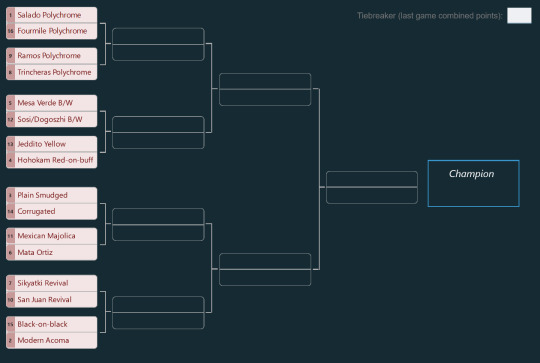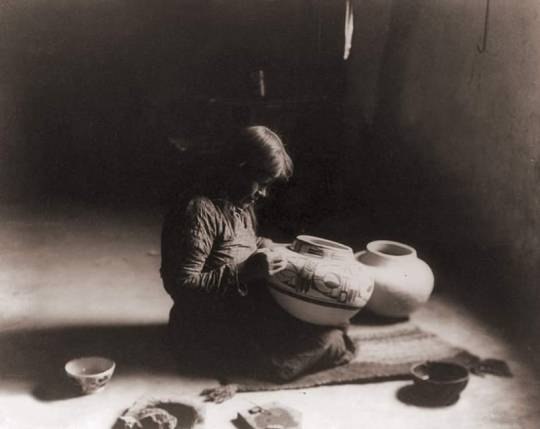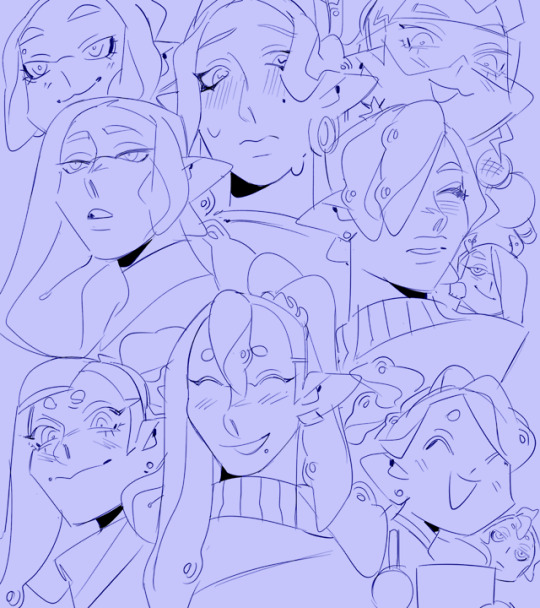#nampeyo
Explore tagged Tumblr posts
Text

“Nampeyo- Famous Hopi potter”
ph: Frashers Foto , Pomona, California
From: “Indians at work” by United States. Bureau of Indian Affairs; United States. Office of Indian Affairs; c.1937
27 notes
·
View notes
Text

Painted ceramic jar.
Nampeyo, 1900 - 1915.
4 notes
·
View notes
Text

Polychrome jar, Nampeyo (Hopi-Tewa)
1 note
·
View note
Text




Jean Sahme Nampeyo, Small Hopi bowl, pot measures 3 3/4" wide at the widest part, 1 5/8" wide at the opening, and 2 1/2" tall.
Artist #bornonthisday Jean Sahme Nampeyo (1948 – ) Sak’Honsee - Tobacco Flower Girl, Hopi/Tewa, is a daughter of Priscilla Namingha Nampeyo and the granddaughter of Rachel Namingha Nampeyo.
Her great grandmother was Annie Healing Nampeyo, whose mother was Nampeyo of Hano. Jean has seven siblings, all of whom are potters or Katsina doll carvers.
Jean Sahme #Nampeyo signature
In addition to her native name Sak'Honsee (Tobacco Flower Girl) signs with a corn plant and a fish. In the corn plant stalk represents the Hopi Pueblo Corn Clan of which Jean is a member. The four leaves represent her two children and her two grandchildren whom Jean mentored. Jean started potting 1965 but is no longer producing pottery. Her work can be found in various galleries, private collections, museums, colleges and universities in the United States and around the world. In 2014 Jean became an Arizona Living Treasure. source: www.adobegallery.com/artist/Jean_Sahme_Nampeyo88098978
photo 2 & 3 http://pueblopottery.net/Jean-Sahme-Hopi-Pottery.htm
"Jean Sahme continues the Nampeyo family tradition of using ancient #Sikyatki designs in her pottery. But, she has moved her pottery forward by adding modern designs as well. Perhaps, what strikes an observer first is how perfectly balanced her pottery is painted."
4. Pot with Snake, ca. 1987, fired clay with clay slip, 5 x 11 5⁄8 in. (12.7 x 29.5 cm) diam., Smithsonian American Art Museum, Gift of Chuck and Jan Rosenak and museum purchase made possible by R.C.Johnson, 1997.124.172
#JeanSahmeNampeyo #artherstory #artbywomen #womensart #palianshow #hopi #hopipottery #native #nativeart #nativecraft #nativeAmerican
5 notes
·
View notes
Text
The Bracket!
Thank you to everyone who was interested and everyone who voted! You chose Tusayan (Sosi/Dogoszhi) and Mesa Verde to represent our black-on-whites, and Plain Smudged and Corrugated to represent our utility ware types! (I was not expecting such a plain smudged sweep - I love to see the enthusiasm!)
So, without any more ado, here is the Finalized Pottery Bracket!

There are SO many more pottery types than these 16, and every time I go to a museum or search up on my favorite Southwest pottery reference websites (New Mexico Office of Archaeology's Pottery Typology Project and Northern Arizona University's American Southwest Virtual Museum) I am reminded of just HOW many different pottery styles there are and how I want to show all of them off...
But these sixteen cover a wide range of styles, locations, and time periods, and give a good sweep of pottery history of the Southwest!
Instead of being separated into seeds, they're grouped by theme. More details on each matchup below:
Tournament 1: Northern Polychromes. Salado Polychrome (that is, Roosevelt Red Ware, Pinto/Gila/Tonto polychrome) vs. Fourmile Polychrome (and the closely associate St. Johns Polychrome). Red, white, and black pottery made in Arizona and New Mexico.
Tournament 2: Southern Polychromes. Ramos Polychrome vs. Trincheras Polychrome. Red, black, purple, and cream pottery made in Chihuahua and Sonora.
Tournament 3: Triumphant Black-on-whites. The return of Mesa Verde Black-on-white and Sosi & Dogoszhi Black-on-white, going head to head!
Tournament 4: Yellow-ish wares. Ancestral Hopi Jeddito Yellow Ware (including the dramatic Sityatki Polychrome) from the Hopi Mesas of Arizona vs. Hohokam red-on-buff types (including Sacaton Red-on-buff and Santa Cruz Red-on-buff) from southern Arizona.
Tournament 5: Return of the Utility Wares. New corrugated and new plain smudged types, still mostly from the Mogollon region both, going to single elimination!
Tournament 6: Mexican Originals. Mexican Majolica, in its distinctively popular type Talavera, the brilliantly colored pottery from the Spanish colonial period in the 1600s, is primarily associated with Puebla, Mexico, which is rather far south of our US Southwest/Mexican Northest topic area, but has for centuries been a popular throughout Spanish-influenced Mexico and the US Southwest. Mata Ortiz, meanwhile, is a modern art pottery style developed in the 1960s in Chihuahua, taking inspiration from the archaeological pottery of Paquimé (including Ramos Polychrome).
Tournament 7: Pueblo Revivals. Sikyatki Revival is the name given to the style of Hopi pottery developed by the Hopi-Tewa potter Nampeyo in the late 1800s based on archaeological pottery from excavations at Sikyatki Village; vs. San Juan Revival, a pottery movement by potters of Ohkay Owingeh Pueblo (formerly known as San Juan Pueblo) starting in the 1930s.
Tournament 8: Modern Pueblo Art. Some of my personal favorite pottery styles picked out from many, many artists working in the Southwest today, Black-on-black (matte black on polished black, or vice versa) pottery developed in the 1910s by a San Ildefonso potter, and still popular primarily in Santa Clara and San Ildefonso Pueblos, vs. Modern Acoma Pottery, a distinctive style in bold reds, whites, and blacks that is just. Gorgeous. You'll see. (I don't mean to diss modern Hopi and Zuni and Navajo and everyone else's styles by not including them, because they're also beautiful and striking, but I had to stop somewhere!)
11 notes
·
View notes
Text

Pot design after the Nampeyo family, titled "Southwest Migration".
11 notes
·
View notes
Text

Native American Indoor Potter Woman Tewa Hopi Edward S Curtis 1900s 1900
Tewa Hopi potter Nampeyo seated on mat painting designs on pottery. - Curtis - 1900
Nampeyo (1859 –1942) was a Hopi-Tewa potter who lived on the Hopi Reservation in Arizona. Her Tewa name was also spelled Num-pa-yu, meaning “snake that does not bite”.
24 notes
·
View notes
Text

#Hopi #Pueblo (Above, top) Polacca polychrome bowl, Hopi, 19"" century. Gift of John Mitchel (Beside, middle) Jar signed by Dextra Quotskuyua Nampeyo. Hopi, 1984. Gift of Audrey Melamed.
2 notes
·
View notes
Text
Cupid’s Arrow - Editorial Review
Title: Cupid’s Arrow Author: Susan English Genre: Science Fiction / Romance How far would you go for the one you love? Faced with an existential threat and an even bigger threat to her home planet, biologist Pavani Nampeyo makes the ultimate sacrifice to protect her people from impending tyranny, losing her true love and soulmate in the process. Together with a team of strong women, and aided…

View On WordPress
#authors#blog#blogging#book reviews#books#Editorial Reviews#fiction#literature#reading#science fiction#writers#writing
1 note
·
View note
Text

A grouping of pottery by Nampeyo (1859-1943)
#history#art history#world history#pottery#ceramics#artblr#craftblr#nampeyo#hopi#hopi-tewa#sikyatki revival#native american art#natice american artist#indigenous art#indigenous#indigenous people#indigenous history#native america#native americans#native art#native women#indigenous women#quootsva
205 notes
·
View notes
Photo

Seed Jar with Sikyatki Motifs, Nampeyo, 1895, Art Institute of Chicago: Arts of the Americas
Since historical records have been kept, Pueblo potters have been almost exclusively women. There is every reason to expect that this has always been true. Nampeyo became the most famous potter who revived Hopi ceramic art around the turn of the 20th century. Drawing upon archaeological Sikyatki shapes, colors, and motifs, Nampeyo created her own inventive designs, continuing the Pueblo tradition of resynthesis and renewal. Today her descendants Dextra Quotskuyva Nampeyo and Fannie Nampeyo carry on the tradition, along with many other excellent potters throughout the Pueblo world. Laura T. Magnuson and Mary Louise Stevenson endowments Size: 17.8 × 40.6 cm (7 × 16 in.) Medium: Ceramic and pigment
https://www.artic.edu/artworks/180751/
13 notes
·
View notes
Text

“Nampeyo: 'Sikyatki revival/Hano polychrome pottery by Nampeyo and her family. Photograph by Seth Roffman; courtesy Dr. Gregory Schaaf collection.”
From: “St. James guide to native North American artists” 1998.
4 notes
·
View notes
Text

Nampeyo, the matriarch of a pottery dynasty on the Hopi Reservation in Arizona.
CHECK AND ADD INFO.
1 note
·
View note
Photo

Seed Jar, Nampeyo, c. 1900, Minneapolis Institute of Art: Art of Africa and the Americas
tan with two brown bands around center; hole top center surrounded by brown box-shape; symmetrical brown and blue designs on each side of box-shape Size: 3 3/4 x 8 7/8 in. (9.53 x 22.54 cm) Medium: Clay, pigments
https://collections.artsmia.org/art/5134/
9 notes
·
View notes
Photo

Jar by Nampeyo, Metropolitan Museum of Art: Arts of Africa, Oceania, and the Americas
Ralph T. Coe Collection, Gift of Ralph T. Coe Foundation for the Arts, 2011 Metropolitan Museum of Art, New York, NY Medium: Ceramic
http://www.metmuseum.org/art/collection/search/319215
10 notes
·
View notes
